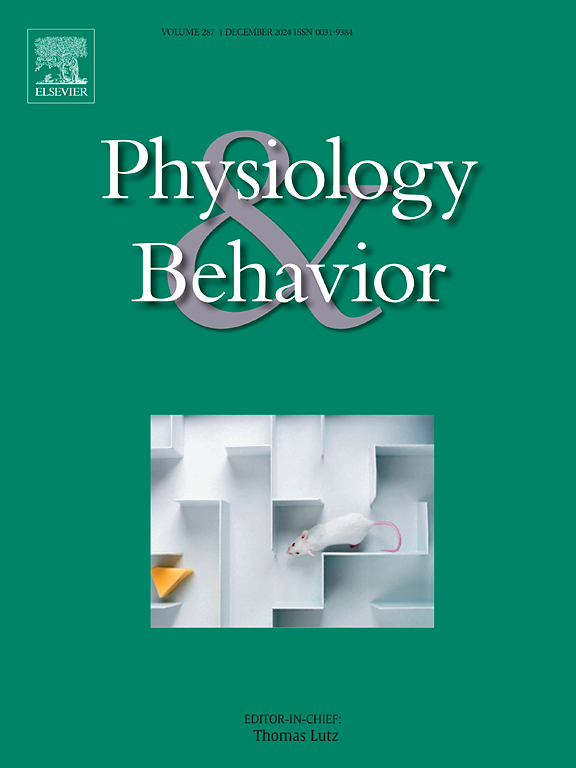A social conditioned place preference test and pair maintenance in the monogamous zebra finch
IF 2.4
3区 医学
Q2 BEHAVIORAL SCIENCES
引用次数: 0
Abstract
Social relationships are essential for a wide range of species, including humans. The mechanisms of pair formation and maintenance appear to be distinct, although relatively little is known about pair maintenance compared to bond formation. A social conditioned place preference (SCPP) test, a paradigm not often used, could be used to reveal differences in the mechanisms of bond formation and maintenance. Here we used the SCPP test across two experiments to investigate how the behavioral and neuroendocrine mechanisms of social affiliation change over the course of pair bonding in the monogamous zebra finch. In our procedure, we had three 30 min phases: preconditioning occurring on Day 1, followed by conditioning and postconditioning, both on Day 2. In our first experiment, we simply asked whether courting and paired dyads would form SCPPs in this assay. We found evidence that courting, but not paired birds, formed SCPPs. This was particularly evident for courting females. Courting and paired dyads also engaged in different behaviors during the conditioning phase. Despite these effects of social context on behavior, there was no clear relationship between these behavioral differences and the formation of SCPPs for courting males or females. We next tested whether pharmacological treatment with D1 and D2 receptor agonists would alter the effects of social context on the formation of SCPPs. Specifically, we hypothesized that treatment with a D1-agonist (SKF 38393) would block the formation of SCPPs in courting dyads and that activation of D2-like receptors (quinpirole) would induce SCPPs in already established pairs. In contrast with Experiment 1, we did not see any groups forming SCPPs, but paired males, regardless of pharmacological treatment, appeared to form aversions to the conditioning side. Furthermore, there was significantly less courtship and affiliative behavior in the second experiment. Combined, this leads us to suspect that coupling the SCPP with an s.c. injection made the entire procedure too aversive to reveal any SCPP. Despite this, there were subtle effects of pharmacological manipulation on social behavior during the conditioning phase. All together, the results from our two experiments (1) suggest that there are differences in the mechanisms by which courting and paired dyads relate to their partner in novel environments, (2) highlight the differences in social interactions between courting and paired birds, and (3) leave open the possibility that dopamine signaling differentially shapes social behavior and the formation of SCPPs in courting and paired birds.
一夫一妻制斑胸草雀的社会条件位置偏好测试和配对维持
社会关系对包括人类在内的许多物种来说都是必不可少的。虽然与键的形成相比,对偶的维持机制所知相对较少,但其形成和维持机制似乎是不同的。社会条件位置偏好测试(social conditioned place preference, SCPP)是一种不常用的测试范式,可以用来揭示纽带形成和维持机制的差异。本研究通过两个实验的SCPP检验,探讨了一夫一妻制斑胸草雀在配对过程中社会关系的行为和神经内分泌机制的变化。在我们的程序中,我们有三个30分钟的阶段:预处理发生在第1天,然后是条件反射和后条件反射,都在第2天。在我们的第一个实验中,我们简单地问在这个实验中,求爱和配对的二联体是否会形成SCPPs。我们发现了求爱而不是配对的鸟类形成scp的证据。这在向雌性求爱时尤为明显。在条件反射阶段,求爱和成对的二联体也有不同的行为。尽管社会环境对行为有这些影响,但这些行为差异与追求雄性或雌性的scp形成之间并没有明确的关系。接下来,我们测试了D1和D2受体激动剂的药物治疗是否会改变社会环境对SCPPs形成的影响。具体地说,我们假设用d1激动剂(SKF 38393)治疗会阻断求偶二体中SCPPs的形成,而激活d2样受体(喹匹罗)会在已经建立的对中诱导SCPPs。与实验1相比,我们没有看到任何群体形成SCPPs,但无论药物治疗如何,成对的雄性似乎对条件反射侧形成厌恶。此外,在第二个实验中,求爱和附属行为显著减少。综上所述,这使我们怀疑将SCPP与sc注射相结合使整个过程过于令人厌恶而无法显示任何SCPP。尽管如此,在条件反射阶段,药理学操作对社会行为有微妙的影响。综上所述,我们的两个实验结果(1)表明,在新的环境中,求爱和配对的二联体与伴侣的联系机制存在差异,(2)突出了求爱和配对鸟类之间社会互动的差异,(3)为多巴胺信号不同地影响求爱和配对鸟类的社会行为和scp形成的可能性提供了可能性。
本文章由计算机程序翻译,如有差异,请以英文原文为准。
求助全文
约1分钟内获得全文
求助全文
来源期刊

Physiology & Behavior
医学-行为科学
CiteScore
5.70
自引率
3.40%
发文量
274
审稿时长
47 days
期刊介绍:
Physiology & Behavior is aimed at the causal physiological mechanisms of behavior and its modulation by environmental factors. The journal invites original reports in the broad area of behavioral and cognitive neuroscience, in which at least one variable is physiological and the primary emphasis and theoretical context are behavioral. The range of subjects includes behavioral neuroendocrinology, psychoneuroimmunology, learning and memory, ingestion, social behavior, and studies related to the mechanisms of psychopathology. Contemporary reviews and theoretical articles are welcomed and the Editors invite such proposals from interested authors.
 求助内容:
求助内容: 应助结果提醒方式:
应助结果提醒方式:


